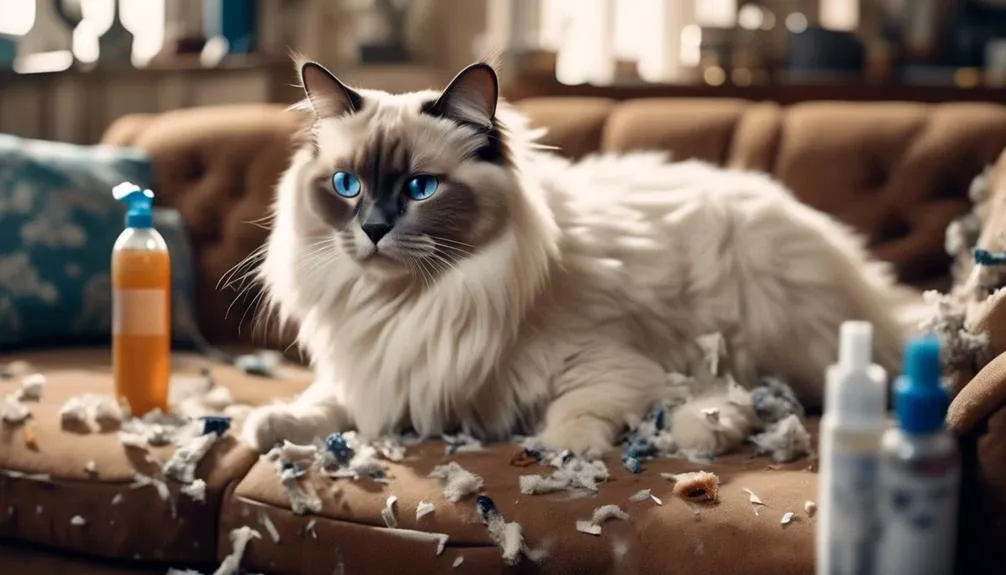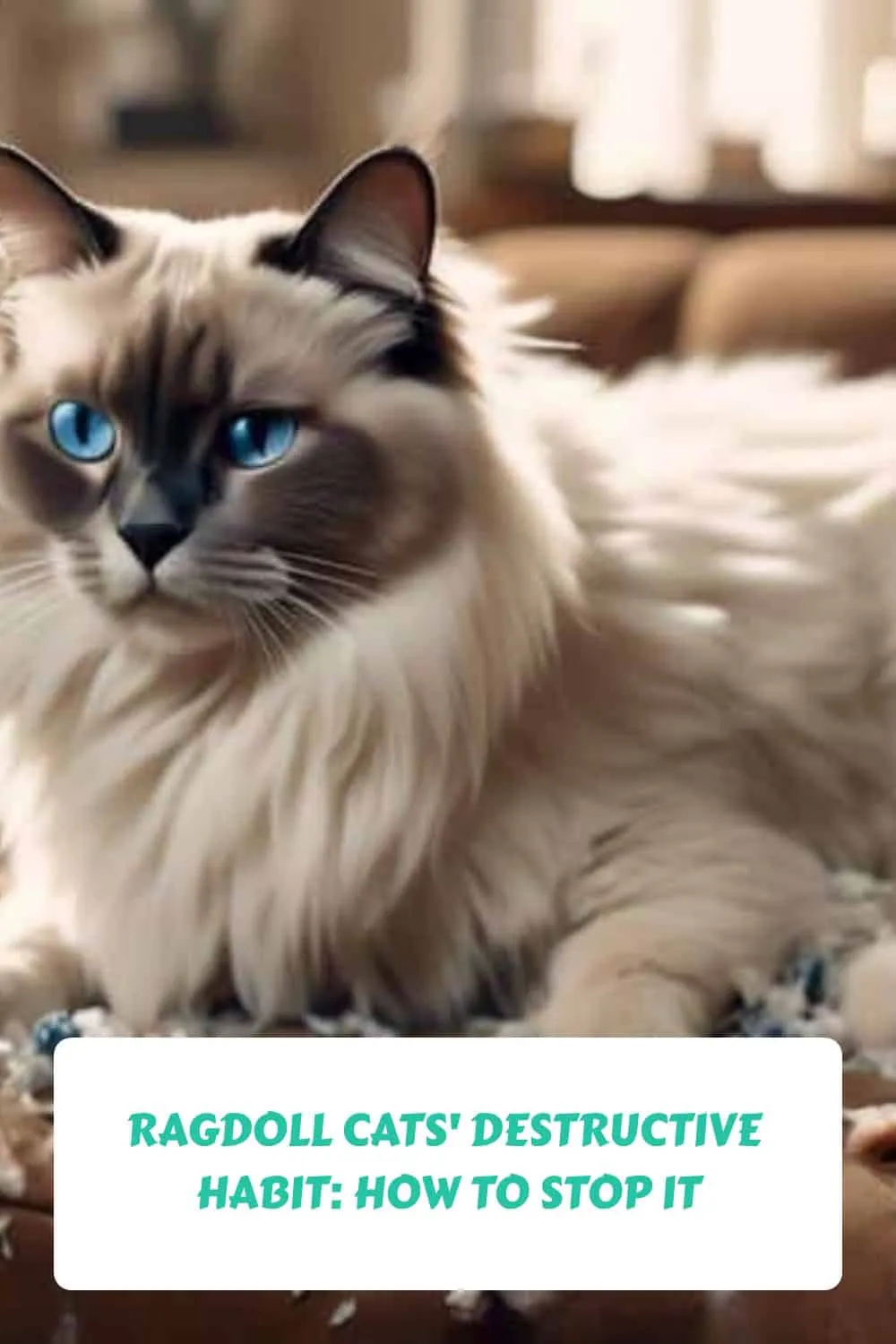The Best Fluffy Pancakes recipe you will fall in love with. Full of tips and tricks to help you make the best pancakes.

Ragdoll cats, known for their striking blue eyes and gentle temperament, can be wonderful companions. However, like any other feline, they have a natural tendency to scratch furniture, causing frustration and damage for their owners. Understanding the reasons behind this destructive habit is key to finding effective solutions.
In this article, we will explore the underlying factors that contribute to Ragdoll cats' scratching behavior and provide practical tips on how to redirect their instincts and protect your furniture. So, if you're tired of finding your prized possessions in tatters, keep reading to discover how you can put an end to this destructive habit and create a harmonious environment for both you and your furry friend.
Key Takeaways
- Scratching is a natural instinct for Ragdoll cats, driven by various reasons such as scent marking and claw maintenance.
- Providing appropriate scratching areas, like sturdy scratch posts or cat trees, can redirect their scratching behavior away from furniture.
- Regularly trimming your Ragdoll's claws can help minimize damage to furniture.
- Engaging your Ragdoll in regular play sessions can alleviate boredom and reduce the likelihood of furniture scratching.
Reasons for Ragdoll Cats' Destructive Scratching
Destructive scratching in Ragdoll cats can be attributed to several reasons, primarily driven by their natural instincts and the lack of appropriate scratching outlets. Understanding cat behavior is crucial in addressing this issue.
Cats scratch to deposit their scent, shed claw husks, and sharpen their claws. It is also a way for them to stretch and release pent-up energy. When Ragdoll cats don't have suitable scratching areas, they may resort to scratching furniture. Boredom can also contribute to this behavior.
To prevent destructive scratching, training techniques for cats can be employed. Providing a sturdy scratch post or cat tree is essential to fulfill their scratching needs. Redirecting the scratching behavior can be done by luring them to the scratch post with treats and placing it near or in front of the targeted furniture.
Regularly trimming their claws and engaging them in play sessions can also help minimize destructive scratching.
Providing Appropriate Scratching Alternatives
To address the destructive scratching behavior of Ragdoll cats, it is crucial to provide appropriate alternatives for them to fulfill their natural scratching instincts. Here are some key strategies to consider:
- Choosing the right scratch post: Select a sturdy and stable scratch post or cat tree that won't wobble or fall over.
- Alternative scratching surfaces: Offer a variety of scratching surfaces, such as sisal mats, cardboard scratchers, or wooden posts, to cater to your cat's preferences.
- Training techniques: Use reward-based methods and positive reinforcement to teach your Ragdoll to use the designated scratching areas.
- Distraction techniques: Redirect your cat's attention from furniture by engaging them in interactive play sessions or providing puzzle toys.
- Environmental enrichment: Ensure your cat's environment is enriched with toys, scratching posts, and climbing structures to keep them mentally stimulated and physically active.
Redirecting the Scratching Behavior
To redirect a Ragdoll cat's destructive scratching behavior, it is important to provide them with appropriate scratching alternatives and employ effective training techniques.
One effective training technique is to use treats or toys to entice your Ragdoll to the scratch post. You can also pick up your Ragdoll and place them directly on the scratch post, demonstrating the scratching motion yourself to show them how it's done.
Positioning the scratch post strategically near the furniture they are scratching can also help redirect their behavior. Positive reinforcement and praise when your Ragdoll uses the scratch post can reinforce the desired behavior.
Additionally, regular claw trimming can help minimize damage to furniture. If necessary, you can seek professional help for nail trimming.
Using deterrent sprays on the furniture can also discourage your Ragdoll from scratching in unwanted areas.
Importance of Regular Claw Trimming
Regular claw trimming is an essential aspect of maintaining a Ragdoll cat's well-being and preventing damage to furniture. Trimming your cat's claws not only helps to minimize the destruction caused by scratching but also promotes good hygiene and reduces the risk of injury.
Here are some important points to consider:
- Benefits of using scratching posts for Ragdoll cats:
- Provides a designated area for scratching, redirecting their behavior away from furniture.
- Helps cats shed claw husks and maintain healthy claws.
- Allows them to stretch their muscles and release energy.
- Promotes mental stimulation and prevents boredom.
- Creates a sense of territory and security for your cat.
Tips for creating an engaging play environment for Ragdoll cats:
- Offer a variety of toys to keep them entertained and active.
- Use interactive toys that simulate hunting and pouncing.
- Rotate toys regularly to keep their interest.
- Set up play areas with climbing structures and hiding spots.
- Engage in play sessions with your cat to strengthen the bond and provide exercise.
Tips for Preventing Furniture Damage by Ragdoll Cats
In order to protect your furniture from damage caused by your Ragdoll cat's scratching habits, implementing a few preventive measures can be highly effective.
One of the key solutions is to provide your Ragdoll cat with sturdy scratch posts or cat trees that fulfill their scratching needs. These should be placed near or in front of the furniture they are targeting. It is important to choose a scratch post that is stable and won't wobble or fall over.
Additionally, make the scratch post more appealing by placing it in a desirable location and considering the size and texture that matches your Ragdoll's preferences. Redirecting your cat's scratching behavior can also be helpful.
Use treats or toys to entice them to the scratch post, and demonstrate scratching on the post yourself to show them how it's done. Position the scratch post strategically near the furniture they are scratching. Positive reinforcement and praise should be used when your Ragdoll uses the scratch post.
Conclusion
In conclusion, understanding the reasons behind Ragdoll cats' destructive scratching behavior is essential in finding effective solutions to prevent further damage. By providing appropriate scratching alternatives, redirecting their behavior, regularly trimming their claws, and reducing boredom through engaging play sessions, owners can create a harmonious environment where their Ragdoll cats can express their natural instincts without causing havoc in the home.
While it may take time and consistent training, these strategies can help deter furniture damage and maintain a peaceful coexistence with these beloved feline companions.
[ANTICIPATED OBJECTION]: Some may argue that declawing is a solution to prevent furniture damage by Ragdoll cats. However, it is important to note that declawing is a painful and invasive procedure that can have long-lasting physical and psychological effects on the cat. Instead, it is recommended to explore alternative solutions that prioritize the cat's well-being and natural behaviors.










